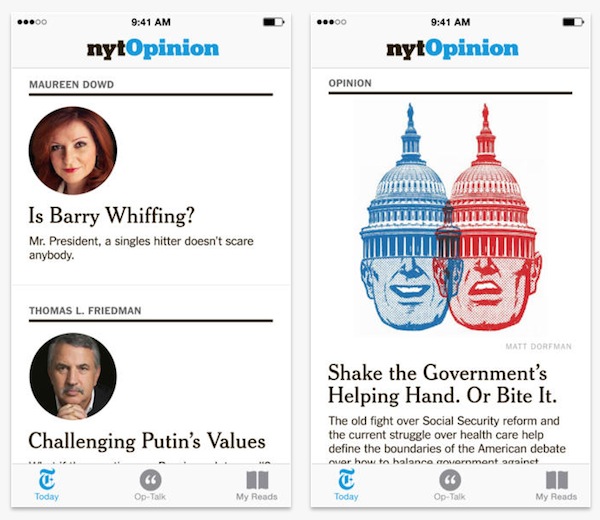
The New York Times’ announcement today that it was cutting 100 positions in its newsroom was coupled with changes to two of its most closely watched experiments, each just a few months old: NYT Now and NYT Opinion. The two apps will meet different fates: NYT Now will live on with a tweaked subscription model, while NYT Opinion will be shut down at month’s end, having been unable to find a substantial paying audience.
The two apps are small parts of the Times’ overall financial picture, which shows a few more positive elements, like a jump in digital advertising revenue. But they were key to the Times’ strategy of creating a fleet of paid apps to target smaller audiences that wouldn’t pay for a full subscription. (Growth in that full-freight number has begun to slow.)What did the Times learn along the way to today?
NYT Opinion, unveiled in June, was available for $6 every four weeks, offered access to opinions and op-eds in the app and on NYTimes.com, and was aimed at a readership who wants to spend more time with opinion writers. It was the second time the paper had tried to created a premium subscription option based around its opinion content, following the short-lived TimesSelect.

Andy Rosenthal, editorial page editor for the Times, said the app’s audience was loyal, but that it had trouble breaking out a small core. “It wasn’t getting a new group of readers in the same way that Now does,” he said. “The sheer volume of people looking at it wasn’t enough to sustain it.” The app pushed Times writing and columns into new territory and made the opinion staff more innovative, he said. “This is not us saying it didn’t work as a journalistic venture; it did,” Rosenthal said. “It’s just not working as a business.”
Like NYT Now, NYT Opinion also offered choice cuts from writers from around the web, aggregation with a Times stamp of approval. Rosenthal said the curation in the Op-Talk section of the app consistently received good reviews from subscribers — but actual usage data shows people didn’t click on it very often. One feature users did enjoy was the follow function, which let users track the latest work from their favorite writers. So if you wanted to be notified whenever Paul Krugman drops knowledge or Maureen Dowd snarfs a pot candy, NYT Opinion would notify you.
A surprising number of NYT Opinion users subscribed through the website, not the app, so the paper plans to experiment with a digital-only subscription plan for opinion content — a strategy that will also let the Times honor the subscription of existing users of NYT Opinion.
Rosenthal said parts of NYT Opinion will live on in other digital products from the Times. The follow feature, along with the commenting functions on pieces — the first inside a Times iOS app — could be put to use in NYT Now or the flagship Times app, he said. For the opinion team, which has tried to branch out into more interactive work with projects like Op-Docs, Rosenthal said building an app was a valuable experience. “What we discovered is we can do this and do it fast from an editorial standpoint,” he said.The Times bulked up the opinion staff for launch, with a small team dedicated to the app. Those jobs will no longer exist.
It was initially targeted at a younger, mobile-friendly audience — but it ended up finding a difference audience too. NYT Now editor Clifford Levy said there was an older audience that subscribed to NYT Now just for cheaper access to the Times’ website, versus younger users who were only using the app.
“The challenge that we face is that when one subscription package is basically going after two different audiences, it creates a lot of internal tensions, or tensions in the business model, and that’s what we’re trying to resolve now,” Levy said. “As Arthur and Mark said in their note this morning, we’re untangling those two areas.”

In the memo to Times’ staff today, Sulzberger and Thompson wrote that NYT Now has succeeded in attracting younger readers to the Times, but the “effort to define and market a lower-priced subscription offer on the web and core apps has proven much less successful.”
The Times is planning on introducing a different pricing model for NYT Now now that only includes access to the app, while also offering a website-only option cheaper than current digital-only subscriptions, Levy said. (In the memo, Sulzberger and Thompson wrote that the Times has “already begun to test other, more intuitive lower-priced subscription offers.”)
Still, Levy said the share of NYT Now app users who are under 35 is “much higher than on any other New York Times platform,” and the Times hopes to continue to retain and grow that audience by focusing its marketing for NYT Now on the app as well as introducing new features.
 In the past month, NYT Now added buttons to save or share each individual story from the app’s main page without actually opening the article. Those small additions “sharply increased engagement,” Levy said. One of the advantages of iOS 8 for news organizations is increased customization of push alerts, and Levy said NYT Now plans to add more functionality there.
In the past month, NYT Now added buttons to save or share each individual story from the app’s main page without actually opening the article. Those small additions “sharply increased engagement,” Levy said. One of the advantages of iOS 8 for news organizations is increased customization of push alerts, and Levy said NYT Now plans to add more functionality there.
Last month, NYT Now also began an experiment with the Indiana Daily Student, the student newspaper at Indiana University, by including IDS stories in NYT Now for users who log in with an IU email address. Though he wouldn’t go into specifics, Levy said the Times is “pushing forward with other experiments like that.”
The Times’ leaked innovation report emphasized the need for the paper to rethink how it approached mobile. “Instead of running mobile on autopilot, we need to view the platform as an experience that demands its own quality control and creativity,” the report read, and Levy emphasized that NYT Now is a critical component in the Times’ thinking in how it approaches both mobile and new product development.“We’ve learned a tremendous amount in terms of how to create new products,” Levy said. “We’ve certainly made mistakes on all these products, but we’ve really learned from them.”
The Times, for example, officially launched NYT Cooking as a standalone site and iPad app last month. For now, the site and app are both free to access and in the two weeks since it came out of beta it’s attracted more then 1 million unique visitors, according to the staff memo. But the decision to keep NYT Cooking free, at least for the period after its launch, was influenced by the paper’s experience with NYT Now and NYT Opinion, Levy said.“We did that in part because we realized that perhaps we went too fast toward monetizing NYT Now and NYT Opinion,” Levy said. “Maybe in the future, a better path is to first do audience development and then do monetization.”